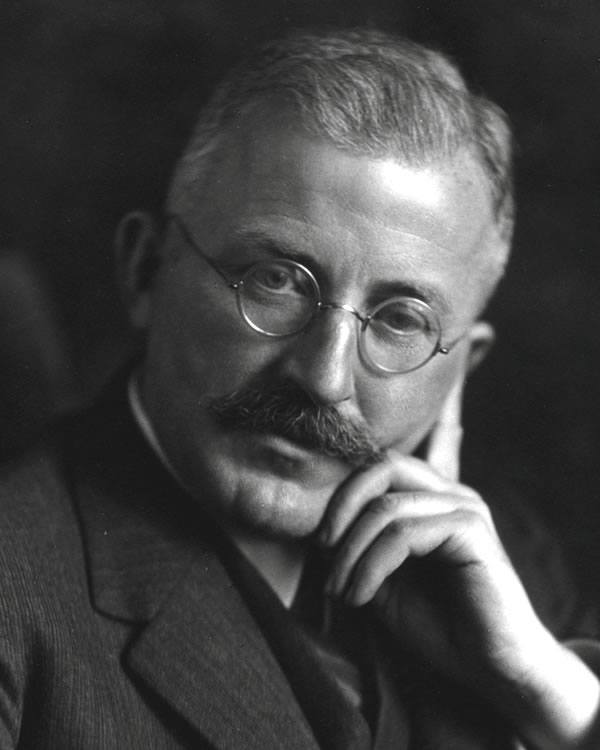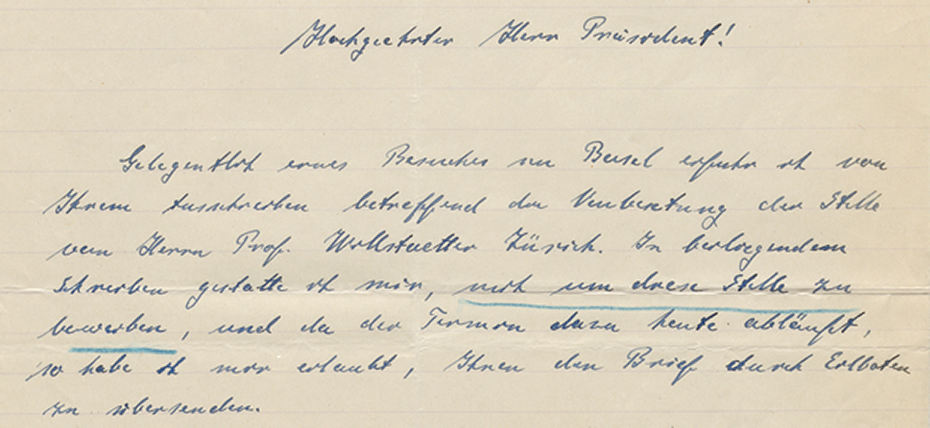Hermann Staudinger (1881–1965)
Professor of general chemistry at ETH Zurich

Hermann Staudinger was born in Worms on 23 March 1881 to Auguste Staudinger-Wenck, a feminist, and Franz Staudinger, a secondary school teacher, philosopher and senior member of the socialist Consumer Co-operative Movement in Germany.
After graduating from school in Worms in 1899, he embarked on a degree in botany and chemistry at the University of Halle an der Saale.
Stay abroad
In the autumn of the same year, he continued his degree in chemistry at the Technical University of Darmstadt and spent two semesters in Munich before returning to Halle in 1901, where he completed a doctorate in 1903. He then worked as a scientific assistant at the University of Strasbourg, where he discovered the first ketenes in 1905.
Marriage and habilitation
He was married to Dorothea Förster from 1906 to 1925. The couple had three daughters and one son.
In the spring of 1907 Staudinger became a professor with a project on ketenes at the University of Strasbourg. The following autumn, he was made an associate professor and at the end of 1910 a full professor of organic chemistry at the Technical University in Karlsruhe. Besides further research on ketenes and aliphatic diazo compounds, he also studied the composition of rubber and – together with his assistant and eventual ETH Zurich professor Leopold Ruzicka – insect poison from a Dalmatian chrysanthemum species.
Professorship for general chemistry
During a visit to Basel, Staudinger learned that ETH Zurich was advertising a vacancy at the Chair for General Chemistry after the previous professor, Richard Willstätter, had been appointed as Director of the newly founded Kaiser Wilhelm Institute of Chemistry in Berlin-Dahlem. On 3 March 1912, the closing date for applications, Staudinger submitted his to the president of ETH Zurich by courier and was appointed to the chair in the summer.
Research and protest
At ETH Zurich, he continued the work he had started in Karlsruhe while branching out into other research fields, including projects on synthetic pepper, drug synthesis and, together with his colleague Tadeusz Reichstein, coffee aroma during the First World War.
When the USA joined the war in 1917, Staudinger calculated that Germany’s human and technical reserves would no longer be sufficient for victory and advised immediate peace negotiations. From the beginning of 1918, he wrote newspaper articles in collaboration with the International Red Cross, protesting against the use of poison gas and falling out with his friend Fritz Haber, the inventor and vehement proponent of chemical warfare, as a result.
Concept of the macromolecular compounds
Based on his previous research, Staudinger developed his concept of macromolecular compounds from 1920, which remained controversial in expert circles for some time but paved the way for polymer chemistry. He believed that equal molecule sections repeated thousands of times over could join up to form chains. He coined the term "macromolecule" for this creation in 1922.
In 1926 Staudinger took up a position at the University of Freiburg (Germany), where he focused almost exclusively on macromolecular chemistry. Two years later, he married botanist Magda Woit. In collaboration with his wife, he transferred his ideas on macromolecular chemistry to biological structures and thus initiated molecular biology.
Second World War
Denounced by the Gestapo for an un-German political attitude and alleged leakage of chemical production methods to the foreign enemy, the new rector of the University of Freiburg, philosopher Martin Heidegger, attempted to oust Staudinger from his position – albeit unsuccessfully. In the fight for scientific recognition, financial backing from industry and the efforts to secure the status of an important war research facility and thus state support for his institute, Staudinger did not shy away from making anti-Semitic statements against students and rival colleagues in the years that followed. At the end of 1944 the University of Freiburg's Chemical Laboratory was destroyed during a bombing raid.
Retirement and Nobel Prize
After its partial reconstruction, however, Staudinger was able to resume his teaching and research activities in 1947. He retired in early 1951 but continued to run his research department, which had been renamed the Staatliches Forschungsinstitut für makromolekulare Chemie des Landes Baden, in a voluntary capacity until 1956.
In 1953 Staudinger received the Nobel Prize in Chemistry in recognition of his discoveries in the field of macromolecular chemistry. In 1957 and 1958 he embarked on lectures tours to Japan and the USA and, together with his wife, supervised the journal "Die makromolekulare Chemie".
He died in Freiburg on 8 September 1965.
Manuscript

Holdings
The ETH Zurich University Archives house the Historical School Board Archive, which contains Hermann Staudinger's chair documents from his appointment to his resignation. Moreover, it also contains letters to colleagues and other figures, as well as some lecture notes by Staudinger's students in various private scientific holdings, which are also curated by the University Archives.
All Nobel Prize laureates of ETH Zurich at a glance